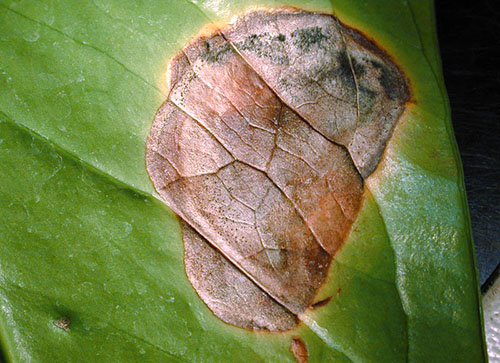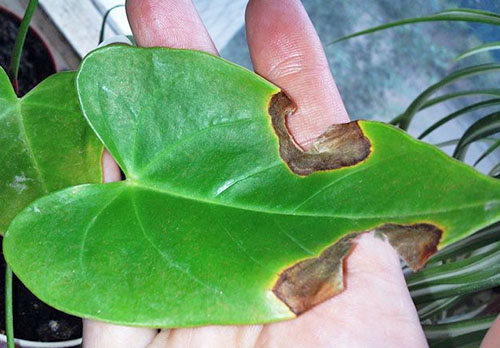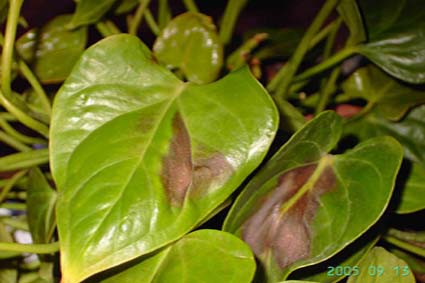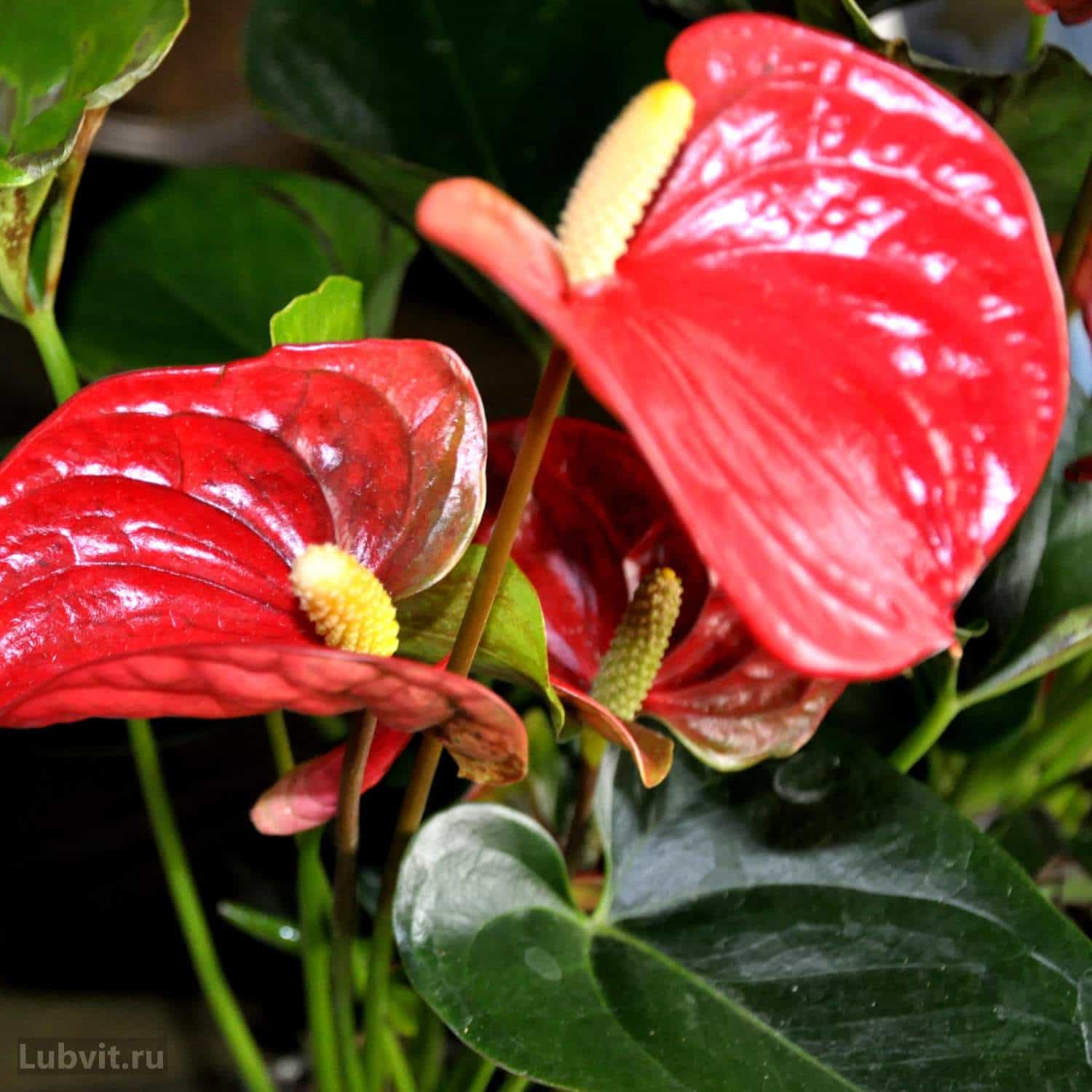Growers claim that the Anthurium is quite unpretentious, resistant to diseases and pests flower, but sometimes problems appear and it. Why are the Anthurium leaves brown spots appear, why they turn yellow and dry? As always, these phenomena three main reasons: improper care, fungal and bacterial diseases and insect pests. Another objective cause yellowing and dropping of leaves – a natural death of old leaves, with a simultaneous increase of new. It is not a disease and do nothing is not necessary.
Improper care
If the leaves of Anthurium appeared brown spots, they began to wilt, turn yellow and dry, most likely it is not properly cared for. The plant died completely, you need to fix the errors in watering, to normalize the schedule of fertilizing, optimize lighting, temperature and humidity.Leaves diseases of Anthurium
Anthurium does not tolerate sudden changes in temperature and prolonged exposure in a cold room. Short-term turmoil in the care and maintenance will not cause him significant harm, but if they delayed, the plant is striking in bacteria and fungi, it ceases to develop normally, the sheets blacken and fall off. As a result, the Anthurium dies completely. Before you begin treatment, you need to create the Anthurium proper conditions.

Anthurium leaves turning yellow from age, nothing to do in this case is not necessary, and there are no such measures that could stop the natural process. As a rule, dry and yellow leaves at the bottom on the stem. First, the tips turn yellow, then the yellowing covers the entire leaf, old leaves have to be removed so they do not spoil the appearance of the plant. At the top of the stem grow new leaves, and flower brushes.
Anthurium leaves are spoiled by excess or deficiencies of light, they appear yellow or brown spots, which spread to the entire leaf plate. Anthurium prefer filtered light, from direct sunlight on its leaves appear brown spots – sunburn. If Anthurium is constantly on a Sunny windowsill, in the summer the glass can be covered with foil or a special tinting film.
Anthurium and is suffering from a lack of light. If it is constantly kept in a dark place, the leaves become pale and weak, which affects the General state of the plant and its appearance.
In low light conditions, the cuttings of the flower elongate, leaves become smaller and fade – that's why winter is necessary to make additional illumination bicolanos or fluorescent lamps.
Dry air is another answer to the question: why on the leaves of Anthurium appear yellow or brown spots and they fall off. In this case, the first spoil tips of the leaves, then the spots spread to the whole sheet of paper, and he dries.
Why is this happening? In conditions of low humidity photosynthesis and metabolic processes in the leaves slow down, they do not receive adequate nutrition, all processes are slowed down, so they wither and die.Leaves diseases of Anthurium
Normal for the Anthurium is the humidity in the 70-85% to create it at home, can be placed next to a pot a container of water, a tray with a damp natural materials such as moss. If you put the pot on a tray with wet expanded clay or moss, you need to make the roots of the plants were not submerged in water they will rot.
Brown spots on the leaves of Anthurium appear due to improper watering, the plant suffers equally from excess or lack of moisture in the soil. The roots of the flower are thick and large, so easy to rot from excess water, besides, in a moist environment reproduce well the putrefactive bacteria and fungi.
You cannot sprinkle some water on Anthurium under direct sunlight. A drop of water becomes a lens, concentrating the light, as a result, the leaves appear burned in the form of brown spots.
Due to wrong leaving antrima developing non-communicable diseases . For example, chlorosis is the result of a deficiency of magnesium and iron in the soil. The leaves have yellow spots, while the veins remain green. Leaves diseases of Anthurium
The pox plant is another disease of Anthurium resulting from improper care. Or rather, because of the shortage of nutrients, high humidity and soil temperatures.

Anazi the disease damages the leaves of Anthurium, they are deformed, becoming covered with growths. These phenomena are the result of improper care – high humidity, sharp change of temperature. After normalization of these factors the disease is.
Rust on leaves of Anthurium can occur due to the use of aerosols to give them a glossy Shine. The composition of aerosols is a paraffin wax that forms on the surface of the sheet a thin film and prevents the evaporation of moisture if the plant reacts to the aerosol therefore, cannot be used.
The leaves blacken and due to improper transplanting and root damage. For planting and transplanting need to use a potting mix of conifers, turf and ground sheet with the addition of sand. Or buy ready-made mix for orchids and bromeliads.
Disease
What diseases affected potted Anthurium? Not so much, and to deal with them is necessary.
Anthracnose is a fungal disease that begins with the fact that the middle of the sheet to form brown spots with a yellow border, they grow gradually, and if you do not take action, the sheet dries completely.Leaves diseases of Anthurium
Anthracnose develops in constantly moist soil with a high pH level, as well as from a lack of potassium and phosphorus. What is the treatment administered in this case? Damaged leaves tear, healthy sprayed pokerside. The treatment is carried out 3-4 times in 10 days. if the status is running, the flower is destroyed completely.

Gray mold – this disease on the leaves of Anthurium spots appear brown or yellow and gray patina, which is nothing like micelles of the fungus.
The disease develops in the case, if the flower is in the room with high humidity and low temperature. Treatment is to increase the temperature, reduce watering, remove and destroy damaged leaves.
If neglected the disease and gray mold hurt the plant very much, it sprayed and watered drugs Oksihom and Topaz. A flower transplanted to another soil, because the fungus spores can be in it. The pot and the soil disinfected.
The Septoria leaf spot – a fungal disease, which is manifested by brown spots on the leaves. Gradually the spots enlarge, and the leaf plate is completely blackened. Fungi spread very fast, this is why damaged leaves should be immediately removed, and the healthy to treat the Alien, Phytosporin or Bordeaux liquid.
Fusarium – in this disease the leaves wilt, turn yellow, wither and fall off.
At the root of the neck there is a white-pink plaque, which is a colony of fungus. The disease develops because of high humidity, a method of treatment of Fusarium does not exist, the plant has to be destroyed. However, if the disease is just beginning to develop, several times to spray the Bush with fungicide, soil disinfected with a pesticide.
Rust – a fungal disease of Anthurium in which the leaves are covered with white spots above and red-brown inside. Over time, the spots spores of the fungus in the form of brown powder. To prevent the spread of fungus and death of a flower, at the first sign of the disease using fungicides.
Pests
What pests are attacking Anthurium most often?
The thrips, or tiny yellow midges appear on the underside of leaves at high humidity. Thrips feed on plant SAP, causing the leaves to dry, covered with spots and fall off. Thrips are dangerous because they carry a viral disease – the bronze leaves. The leaves are discolored, deformed and fall off. Funds from bronzovoi leaf does not exist, affected plants have to be destroyed, that is why it is so important to protect from Anthurium thrips.
Spider mites – insect, damaging leaves. A tick is born in a dry, dusty environment, with the lack of fresh air.Leaves diseases of Anthurium
About the appearance of scale insects say, white or yellow bumps on the leaves. The insects suck the SAP from the leaves, and they are deformed.
Aphids settled on the underside of the leaves and feeds on their juices. As a result, the leaves curl, they get sticky liquid that attracts other insects and harmful bacteria. If no action is taken, the plant will quickly die.
Mealybug leaves on the leaves "flour" that prevents passing them to processes – evaporation of moisture, metabolism and photosynthesis.
Pests destroy chemicals and cover the plant with plastic in order to enhance their effect.
In addition, for the treatment of Anthurium use folk remedies – infusions of garlic, tobacco powder, yarrow. Treatment is required for all plants that are next to the affected Anthurium, it will help to localize the disease and prevent the emergence of pests on other flowers.
